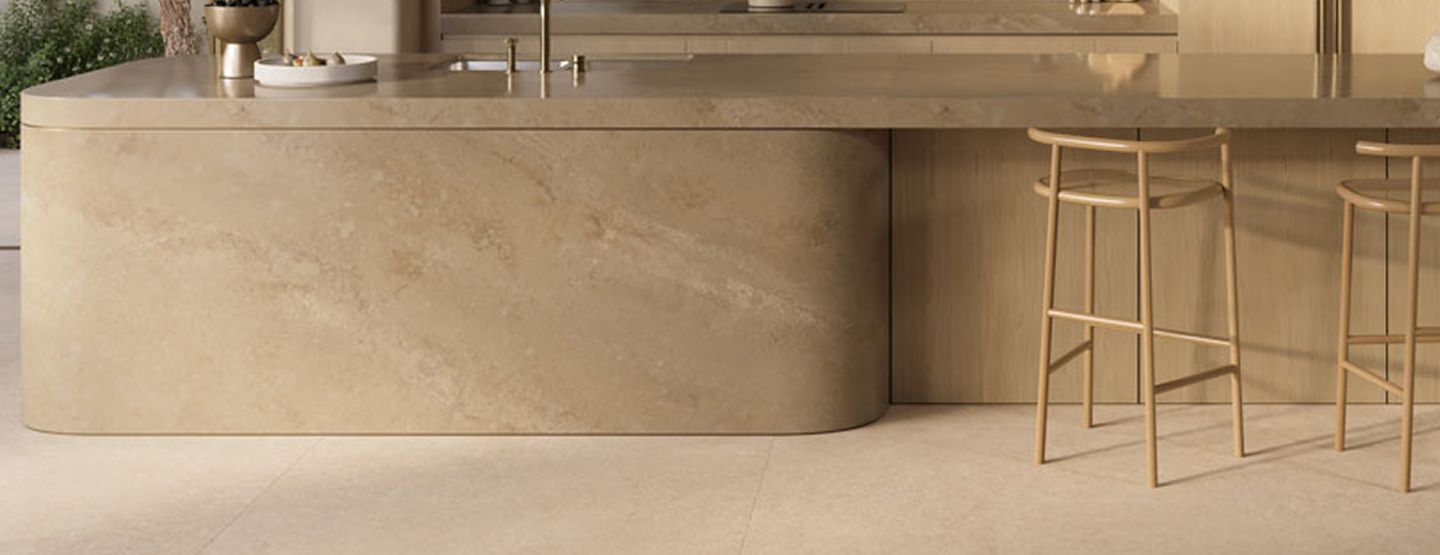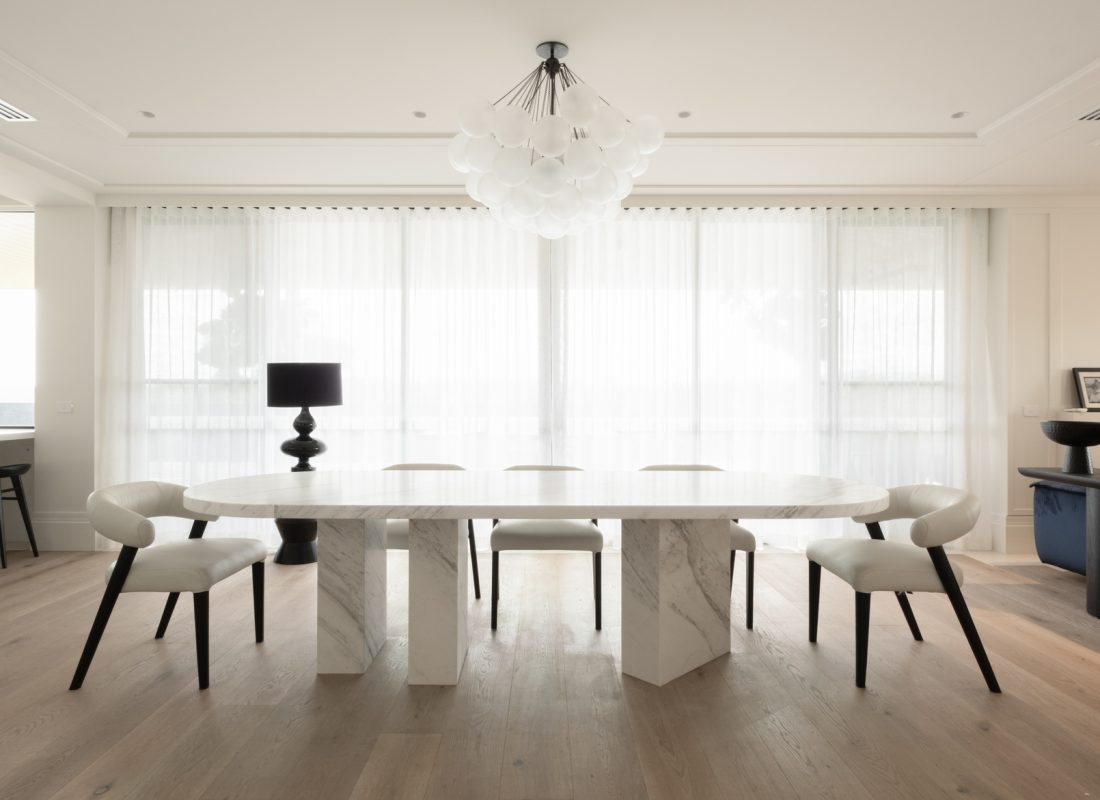Table of Contents
ToggleThe modern kitchen is changing from a purely functional area to an ergonomic and visually appealing living space. This change calls for new materials and manufacturing methods that can overcome the limitations of traditional materials like granite and quartz. The answer lies in thermoforming, a process that opens up a new era of fluid, custom designs in contemporary interiors.
What Is Thermoforming?
Thermoforming is a manufacturing process where a flat sheet of thermoplastic material is heated until it becomes soft and pliable, then shaped into a specific three-dimensional form using a mold, vacuum, or pressure.
In kitchen design, the common choice is acrylic solid surface (like DuPont™ Corian®), a flexible, durable, and non-porous synthetic blend.
Thermoforming vs. Traditional Fabrication
Feature | Thermoforming (Acrylic Solid Surface) | Traditional Fabrication (Stone, Laminate)
Shape Capability | Allows for 3D curves, seamless bowls, and intricate forms. | Limited to straight lines and large radii, with visible seams.
Seams | Can be seamlessly joined and finished, creating a monolithic look. | Seams are visible where two pieces meet.
Flexibility | Material becomes highly flexible when heated, allowing for bending. | Rigid and brittle; cannot be bent into tight curves.
Finish | Can be sanded and polished to a perfectly smooth, non-porous finish. | Finish is dictated by the natural stone or laminate top layer.
Export to Sheets
The key properties of acrylic solid surface—flexibility when heated, durability, and a smooth, repairable finish—make it the best choice for modern, customized kitchen elements.
Step-by-Step Thermoforming Process
The seamless shapes created by thermoforming result from a precise, controlled five-step process:
Step 1: Material Preparation
The acrylic solid surface sheet is cut slightly larger than the final dimensions to allow for shrinkage during cooling. All edges must be smoothed to remove chips or cracks that could create stress points later.
Step 2: Heating
The cut sheet is placed in a thermoforming oven (such as a convection or platen press oven) and heated uniformly to its specific softening temperature, usually between 275°F and 325°F (135°C and 165°C). Keeping the temperature just right is crucial; under-heating can cause cracking, while overheating can lead to blistering.
Step 3: Molding/Forming
The heated sheet is quickly taken from the oven and draped over, or pressed into, a custom mold (often made of MDF or plywood). A vacuum membrane press is often used to remove the air, pressing the material tightly against the mold’s shape and capturing intricate details.
Step 4: Cooling
The material is held firmly in place on the mold until it cools and hardens, taking on its new shape. This step must be carefully controlled to prevent warping or internal stress.
Step 5: Finishing and Assembly
Once cool, the formed piece is removed, then trimmed, sanded, and polished. Multiple thermoformed pieces can be seamlessly joined with a specialized adhesive, creating an installation where seams are nearly invisible.
Benefits of Thermoforming for Kitchen Design
Thermoforming is becoming popular as the future of kitchen design because it offers unique advantages for both designers and homeowners:
- Seamless Curved Surfaces and Edges: The ability to mold materials enables smooth, flowing shapes and soft edges, creating a seamless, organic look. This avoids the sharp corners and visible joints found in stone.
- Endless Design Possibilities and Custom Shapes: Designers can create custom 3D forms that were previously impossible, such as waterfall edges, integrated drain boards, and uniquely shaped islands.
- Easy to Clean and Maintain: The non-porous nature of thermoformed solid surface and the absence of visible seams make it very hygienic. There are no crevices for dirt, mold, or bacteria to hide, and the material is easy to repair if scratched.
- Lightweight Yet Durable: Acrylic solid surface is lighter than natural stone, which simplifies installation, but it remains very durable and resistant to staining and impact.
- Improves Ergonomic and Aesthetic Appeal: Smooth, curved forms are naturally more ergonomic and pleasing to the eye, leading to a more comfortable and modern kitchen experience.
- Eco-Friendly: The process can be very efficient, and acrylic solid surface is typically seen as more sustainable than quarried materials.
Applications of Thermoformed Acrylic Solid Surface
The versatility of thermoformed acrylic solid surface allows it to be used in various kitchen components, enhancing both form and function:
Curved Kitchen Countertops and Islands: Creates a striking centerpiece, especially for rounded or elliptical islands.
Integrated Backsplashes and Sinks: Sinks and backsplashes can be molded directly into the countertop, resulting in a continuous surface with no joints or lips, making cleaning easy.
Custom Cabinet Facings and Panels: Forms unique 3D textures or curved faces for handle-less, modern cabinets.
Decorative Wall Claddings and Shelving: Sculpting architectural features or shelves that blend seamlessly with other kitchen surfaces.
Unique Furniture Pieces and Accent Features: Making custom tables, bar stools, or accent niches that match the main kitchen surfaces.
Why Thermoforming Is the Future of Kitchen Design
Thermoforming is more than just a trend; it’s a technology that meets the needs of modern interior design.
It fulfills the growing demand for minimal and seamless designs, enabling architects to create spaces without the clutter of seams and sharp corners. By supporting efficient manufacturing with less material waste, it fits with today’s focus on sustainability. Most importantly, it provides designers with creative freedom without losing functionality, resulting in surfaces that are beautiful, durable, hygienic, and ergonomic.
This technique is pushing the limits of what’s possible, establishing smooth, fluid kitchens as the new standard for modern residential and commercial spaces.
Conclusion
Ready to transform your kitchen with flowing, curved countertops, and integrated sinks that are completely seamless?
As certified experts in Solid Surface fabrication and the latest thermoforming techniques, Emporium Stone can bring your most ambitious 3D designs to life with impeccable precision and quality.
Stop designing in straight lines. Start designing with Emporium Stone.
Contact the Emporium Stone team for a consultation and discover the seamless possibilities of thermoformed solid surface for your home or commercial project.



